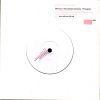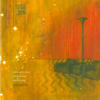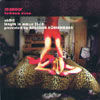 The second single in the Safe as Milk/Melektronikk collaborativeMilkland series brings together two subjects that couldn't be moreopposite from each other, and that seems to be part of the point. Safeas Milk is a Norwegian label that releases acts more rock in nature,while its sister label Melektronikk specializes in acts that areexperimental electronic; so any collaboration between the two will havemixed effects on the psyche, as this one does in spades. Milkland 2features Vibracathedral Orchestra, whose music easily reminds me ofasylums. Not the patients, mind you, because I think this music woulddrive them even more over the edge if they heard it; but I clearly feelthe waiting rooms and observation stations where you can actually seethe afflicted in this music. I imagined an entire dance troupe ofloonies, or as I called them the Psychotic Conservatory, flailingaround in anger, sitting in the middle of the floor chanting nonsense,and crying while jumping up and down. "Rain Gutter Teasing Rusty CatSneezing" is an amalgam of instruments and sounds that is not easilydigested or understood, and although I found it at the same timeinteresting and unnerving, it made me want to listen to their atonaldrone more. Phonophani, on the other hand, a side project of Alogmember Espen Sommer Eide, is manic noise of a far different sort. Beepsand bloops are the main percussion of "Bees - They Will Sting You" fora few seconds, then layer upon layer of flourish and glitch are addedon top, compelling the rhythm and tone into some bizarre roboticchoreography. Eventually, it seems as though the machines are acting ontheir own accord, no longer caring or paying attention to what thehuman programming them is asking or wants. Wonderfully creative musicfrom both artists, even though it makes me ponder whether either has ascrew or two loose.
The second single in the Safe as Milk/Melektronikk collaborativeMilkland series brings together two subjects that couldn't be moreopposite from each other, and that seems to be part of the point. Safeas Milk is a Norwegian label that releases acts more rock in nature,while its sister label Melektronikk specializes in acts that areexperimental electronic; so any collaboration between the two will havemixed effects on the psyche, as this one does in spades. Milkland 2features Vibracathedral Orchestra, whose music easily reminds me ofasylums. Not the patients, mind you, because I think this music woulddrive them even more over the edge if they heard it; but I clearly feelthe waiting rooms and observation stations where you can actually seethe afflicted in this music. I imagined an entire dance troupe ofloonies, or as I called them the Psychotic Conservatory, flailingaround in anger, sitting in the middle of the floor chanting nonsense,and crying while jumping up and down. "Rain Gutter Teasing Rusty CatSneezing" is an amalgam of instruments and sounds that is not easilydigested or understood, and although I found it at the same timeinteresting and unnerving, it made me want to listen to their atonaldrone more. Phonophani, on the other hand, a side project of Alogmember Espen Sommer Eide, is manic noise of a far different sort. Beepsand bloops are the main percussion of "Bees - They Will Sting You" fora few seconds, then layer upon layer of flourish and glitch are addedon top, compelling the rhythm and tone into some bizarre roboticchoreography. Eventually, it seems as though the machines are acting ontheir own accord, no longer caring or paying attention to what thehuman programming them is asking or wants. Wonderfully creative musicfrom both artists, even though it makes me ponder whether either has ascrew or two loose.samples:
- Vibracathedral Orchestra - Rain Gutter Teasing Rusty Cat Sneezing
- Phonophani - Bees - They Will Sting You



 Smyglyssna is Henrik Johansson, a Swedish electronic musician who isdesperately hoping that the music-buying public will be able todistinguish the music on his new album We Can Fix Itfrom that of his numerous European contemporaries. Perhaps I don'tpossess an ear properly tuned towards these subtle distinctions, but itseems that Johansson has produced an album that is more or less wearingthe IDM uniform: a postmodern combination of beats lifted from the past20 years of electronic music, processed and edited within an inch ofits life with the kind of surgical precision only possible with anexpensive new Powerbook. The nine tracks add up to something slightlybetter than average, but slightly less than great. "Might-It-Be's andIf-It-Were's" opens with some creepy alien sound washes, before Mr.Johansson introduces his limited sound palette, which involves CarlCraig-style Detroit electro with all booty-shaking potential carefullyremoved and replaced with a dry, academic contempt for accessibility.It bears more than a passing resemblance to earlier IDM such as BlackDog Productions, with its shifting patterns and cubist beatconstruction. It all comes together nicely, and even achieves somegenuinely funky moments, but I can't help feeling that this kind ofthing was a bit more compelling five years ago. For its entiresix-minute length, "Work Shall Be Abolished" threatens to turn into afull-on electro-funk song, but Johansson is too restrained to engage inanything that might be construed as fun. "Triangular Ears" is probablythe best track on the album, as it is the one time Johansson fullyabsorbs the listener in his infectious beat construction, with funny,eclectic sounds that are reminiscent of Mouse on Mars. The ugly loomingspectre of Boards of Canada haunts most modern electronic artists, andmany seem afraid to venture out of their shadow. Smyglyssna is noexception, with his obvious BoC pastiche "Foaming Prairie," a pastoralkeyboard melody matched with hazy distortions. The R&B flavored"Tea With Angela" finishes the album on a slightly messy note. Ibelieve there is hope for Smyglyssna, if he can somehow manage toremove his head from the collective ass of the European IDMcommunity and make something that sounds a little less like everythingelse.
Smyglyssna is Henrik Johansson, a Swedish electronic musician who isdesperately hoping that the music-buying public will be able todistinguish the music on his new album We Can Fix Itfrom that of his numerous European contemporaries. Perhaps I don'tpossess an ear properly tuned towards these subtle distinctions, but itseems that Johansson has produced an album that is more or less wearingthe IDM uniform: a postmodern combination of beats lifted from the past20 years of electronic music, processed and edited within an inch ofits life with the kind of surgical precision only possible with anexpensive new Powerbook. The nine tracks add up to something slightlybetter than average, but slightly less than great. "Might-It-Be's andIf-It-Were's" opens with some creepy alien sound washes, before Mr.Johansson introduces his limited sound palette, which involves CarlCraig-style Detroit electro with all booty-shaking potential carefullyremoved and replaced with a dry, academic contempt for accessibility.It bears more than a passing resemblance to earlier IDM such as BlackDog Productions, with its shifting patterns and cubist beatconstruction. It all comes together nicely, and even achieves somegenuinely funky moments, but I can't help feeling that this kind ofthing was a bit more compelling five years ago. For its entiresix-minute length, "Work Shall Be Abolished" threatens to turn into afull-on electro-funk song, but Johansson is too restrained to engage inanything that might be construed as fun. "Triangular Ears" is probablythe best track on the album, as it is the one time Johansson fullyabsorbs the listener in his infectious beat construction, with funny,eclectic sounds that are reminiscent of Mouse on Mars. The ugly loomingspectre of Boards of Canada haunts most modern electronic artists, andmany seem afraid to venture out of their shadow. Smyglyssna is noexception, with his obvious BoC pastiche "Foaming Prairie," a pastoralkeyboard melody matched with hazy distortions. The R&B flavored"Tea With Angela" finishes the album on a slightly messy note. Ibelieve there is hope for Smyglyssna, if he can somehow manage toremove his head from the collective ass of the European IDMcommunity and make something that sounds a little less like everythingelse. A little less than a year after the release of We Can Fix It comes the inevitable collection of remixes, which has been creatively titled We Can Fix It Remixes.The remixers chosen for this project must have been asking themselves:Can we fix it? Can something be done to improve the aggressivelyaverage material that Smyglyssna produced for this non-landmark album?The answer is a guarded yes. Modern hip-hop beat assembler Boom Bipturns in an impressive re-imagining of "We Can Fake It," giving thesong a regular beat and adding dramatic melodic elements that make foran entertaining listen, though it ends rather suddenly. England'sFujiya & Miyaga succeed in mutating the boring "Tea With Angela"into a weird pop song, with backwards vocals, handclaps and marimbaadded. Anticon's Sixtoo adds an irregular loping beat to "FoamingPrarie," which neither improves nor detracts from the original, butdoes succeed in making the song sound even more like Boards of Canada.Soft Pink Truth's reworking of "Work Shall Be Abolished" should becalled "Queer Eye for the Boring Swedish Guy," cleverly using his homotouch to transform the boring raw materials into a smart disco-housenumber with weird samples and plenty of attitude. Underground white-boyhip-hop group Restiform Bodies do a strange treatment to "Tea WithAngela," making it sound way more textured and varied than the originalsong. Icelandic artist Einoma ends the disc with the dark, industrialhip-hop groove of his "We Can Fake It" remake. I should probably addthat Smyglyssna also contributes two remixes of his own to this disc.They are both as predictable as the material on his original album. We Can Fix It Remixes certainly does not cohere as an album, but it does contain some good songs that don't betray their trite origins.
A little less than a year after the release of We Can Fix It comes the inevitable collection of remixes, which has been creatively titled We Can Fix It Remixes.The remixers chosen for this project must have been asking themselves:Can we fix it? Can something be done to improve the aggressivelyaverage material that Smyglyssna produced for this non-landmark album?The answer is a guarded yes. Modern hip-hop beat assembler Boom Bipturns in an impressive re-imagining of "We Can Fake It," giving thesong a regular beat and adding dramatic melodic elements that make foran entertaining listen, though it ends rather suddenly. England'sFujiya & Miyaga succeed in mutating the boring "Tea With Angela"into a weird pop song, with backwards vocals, handclaps and marimbaadded. Anticon's Sixtoo adds an irregular loping beat to "FoamingPrarie," which neither improves nor detracts from the original, butdoes succeed in making the song sound even more like Boards of Canada.Soft Pink Truth's reworking of "Work Shall Be Abolished" should becalled "Queer Eye for the Boring Swedish Guy," cleverly using his homotouch to transform the boring raw materials into a smart disco-housenumber with weird samples and plenty of attitude. Underground white-boyhip-hop group Restiform Bodies do a strange treatment to "Tea WithAngela," making it sound way more textured and varied than the originalsong. Icelandic artist Einoma ends the disc with the dark, industrialhip-hop groove of his "We Can Fake It" remake. I should probably addthat Smyglyssna also contributes two remixes of his own to this disc.They are both as predictable as the material on his original album. We Can Fix It Remixes certainly does not cohere as an album, but it does contain some good songs that don't betray their trite origins. There is something about the way this music sounds that brings back memories of some art long lost in electronic music. There is melody, counterpoint, harmony, rhythms based half way between space and hip-hop, and a completely uplifting feeling throughout. Where We're From... is dance-inspiring, but it isn't a dance record; everything swells and flares slowly, emitting a warm light that radiates for miles around.
There is something about the way this music sounds that brings back memories of some art long lost in electronic music. There is melody, counterpoint, harmony, rhythms based half way between space and hip-hop, and a completely uplifting feeling throughout. Where We're From... is dance-inspiring, but it isn't a dance record; everything swells and flares slowly, emitting a warm light that radiates for miles around. It's pretty incredible to hear a keyboardist thrash along with abassist and drummer. It's even more incredible when the keyboardmanages to sound heavier, more melodic, and threatening (all at thesame time) than any guitar could. Groundswellis the debut album from Parts and Labor and to put it simply: it rocks.It's like being strapped into a jet for the first time and beingintroduced to mach-5 and blackouts. Although the keyboard often holdsthe lead role in each song, it's the duo of bassist BJ Warshaw andeither Jim Sykes or Joel Saladino on drums that propel every song intooverdrive. The entire album sounds as if it could've been recorded inan abandoned warehouse somewhere on northern Jersey's shore. The bassis absolutely unhinged, rattling about as if it were on fire and readyto explode. Above it all is an unexpected partner: the keyboardtwirling, performing loops, convulsing, and generally ejaculating overeverything. It serves another role, however: every now and then gentletones and wavering notes will hover over the near-tribal rhythm sectioncreating an odd juxtaposition of sounds that will either producenightmares or light a fire under my ass and send me into thestratosphere. The music isn't particularly violent, but it's LOUD anddetermined to beat the three minute mile. "TB Strut" also happens to beone of the best headbanging songs I've heard, it's just impossible toresist that melody! As a nice little bonus, Parts and Labor haveincluded a video for "Intervention" on the CD (it's also available ontheir website). It's a fun video in a very twisted way. These guys mustbe monstrous live so hopefully they'll expand their tours a bit furtherwest soon.
It's pretty incredible to hear a keyboardist thrash along with abassist and drummer. It's even more incredible when the keyboardmanages to sound heavier, more melodic, and threatening (all at thesame time) than any guitar could. Groundswellis the debut album from Parts and Labor and to put it simply: it rocks.It's like being strapped into a jet for the first time and beingintroduced to mach-5 and blackouts. Although the keyboard often holdsthe lead role in each song, it's the duo of bassist BJ Warshaw andeither Jim Sykes or Joel Saladino on drums that propel every song intooverdrive. The entire album sounds as if it could've been recorded inan abandoned warehouse somewhere on northern Jersey's shore. The bassis absolutely unhinged, rattling about as if it were on fire and readyto explode. Above it all is an unexpected partner: the keyboardtwirling, performing loops, convulsing, and generally ejaculating overeverything. It serves another role, however: every now and then gentletones and wavering notes will hover over the near-tribal rhythm sectioncreating an odd juxtaposition of sounds that will either producenightmares or light a fire under my ass and send me into thestratosphere. The music isn't particularly violent, but it's LOUD anddetermined to beat the three minute mile. "TB Strut" also happens to beone of the best headbanging songs I've heard, it's just impossible toresist that melody! As a nice little bonus, Parts and Labor haveincluded a video for "Intervention" on the CD (it's also available ontheir website). It's a fun video in a very twisted way. These guys mustbe monstrous live so hopefully they'll expand their tours a bit furtherwest soon. Schmoof are the U.K. duo of Sarah and Lloyd, whose over the top kitsch music is firmly rooted in the style of 70s disco meets 80s synth pop production. I'm usually not one to judge a book (or CD) by its cover, but the pink clad, pixelated figures jumping on a leopard print bedspread on Bedroom Disco doesn't exactly leave too much to the imagination as to the type of music to expect.
Schmoof are the U.K. duo of Sarah and Lloyd, whose over the top kitsch music is firmly rooted in the style of 70s disco meets 80s synth pop production. I'm usually not one to judge a book (or CD) by its cover, but the pink clad, pixelated figures jumping on a leopard print bedspread on Bedroom Disco doesn't exactly leave too much to the imagination as to the type of music to expect. Montreal's Soft Canyon are the latest in a recent outcropping of bandsattempting to recreate the power and majesty of 1970's Neil Young-stylepsychedelic-inflected guitar rock. They are also in the unfortunateposition of having named themselves Soft Canyon, a strange choice giventhe fact that Canyon, a Washington D.C. band with a strikingly similarsound, have just recently released their album Empty Roomsto wide critical acclaim. Recording an album inspired by 70's arenarock under such a similar band name makes this Canadian five-piece seema little like copyists, even if they came up with the idea first, whichis doubtful. Furthering their unlucky destiny, their first album Broken Spirit, I Will Mend Your Wings is not nearly as good as Canyon's Empty Rooms,falling far short of the bar set by their obvious influences. Thisincredibly brief album tries and fails to recreate the epic sweep ofNeil Young's Zuma. Their tepid guitar pop has little to offerthe listener, being entirely derivative in a largely uninteresting way.Where Canyon's Empty Rooms was an awe-inspiring set ofmajestic, atmospheric guitar anthems in the mould of "Cortez theKiller", Soft Canyon's Broken Spirit is a snore-inducing half hour ofover-produced, under-written songs that sound more like those late-70'salbums Young phoned in because of contractual obligations. SoftCanyon's vocalist has an annoying, unpolished presence, and the lyricsare lukewarm amalgams of teenage love poetry and fake mysticism. Also,these average pop songs are not given enough room to breathe, mostending before the four-minute mark. Neil Young's spacious,"canyon-esque" guitar solos were the key element in his magical rock n'roll, but the instrumentalists in Soft Canyon are not talented enoughto stand on their own. To cover up for the dearth of musical invention,Broken Spirit's producer has added a number of laughable psychedelicinterludes that seem terribly out of place. By the time I reached thefinal, failed seven-minute epic "We Threw Our Love Into The Universe,"I just wanted to hear the other, superior Canyon. Soft Canyon need togo back to the drawing board for their next record, or they run therisk of creating another disposable cliché of an album destined to beunfavorably compared to their American counterparts.
Montreal's Soft Canyon are the latest in a recent outcropping of bandsattempting to recreate the power and majesty of 1970's Neil Young-stylepsychedelic-inflected guitar rock. They are also in the unfortunateposition of having named themselves Soft Canyon, a strange choice giventhe fact that Canyon, a Washington D.C. band with a strikingly similarsound, have just recently released their album Empty Roomsto wide critical acclaim. Recording an album inspired by 70's arenarock under such a similar band name makes this Canadian five-piece seema little like copyists, even if they came up with the idea first, whichis doubtful. Furthering their unlucky destiny, their first album Broken Spirit, I Will Mend Your Wings is not nearly as good as Canyon's Empty Rooms,falling far short of the bar set by their obvious influences. Thisincredibly brief album tries and fails to recreate the epic sweep ofNeil Young's Zuma. Their tepid guitar pop has little to offerthe listener, being entirely derivative in a largely uninteresting way.Where Canyon's Empty Rooms was an awe-inspiring set ofmajestic, atmospheric guitar anthems in the mould of "Cortez theKiller", Soft Canyon's Broken Spirit is a snore-inducing half hour ofover-produced, under-written songs that sound more like those late-70'salbums Young phoned in because of contractual obligations. SoftCanyon's vocalist has an annoying, unpolished presence, and the lyricsare lukewarm amalgams of teenage love poetry and fake mysticism. Also,these average pop songs are not given enough room to breathe, mostending before the four-minute mark. Neil Young's spacious,"canyon-esque" guitar solos were the key element in his magical rock n'roll, but the instrumentalists in Soft Canyon are not talented enoughto stand on their own. To cover up for the dearth of musical invention,Broken Spirit's producer has added a number of laughable psychedelicinterludes that seem terribly out of place. By the time I reached thefinal, failed seven-minute epic "We Threw Our Love Into The Universe,"I just wanted to hear the other, superior Canyon. Soft Canyon need togo back to the drawing board for their next record, or they run therisk of creating another disposable cliché of an album destined to beunfavorably compared to their American counterparts. After a couple years of hiatus, degrouping and regrouping, John Waters'favorite surrealistic futuristic thrash quartet return with theirlongest album to date. With 23 songs, their debut release for Epitaph'sAnti Records is nearly double the length of their debut and almosteverything else that's emerged from their chrysalis. Credit needs to begiven to the San Diego crew for perhaps being one of the most efficient"rock" groups around, cramming full songs with verses and repeatedchoruses in an astounding amount of time (the longest song that gracesthis record is one second shy of being a minute and a half). The Locusthave clearly passed into a new stage of development. The instrumentalcoordination is top notch, the onslaught is maddening, the coordinationis astounding, and the technological integration is the most prominentas it has ever been. Doctors recommend that adults raise theirheartbeat about 20 minutes every day. At slightly over 20 minutes, Plague Soundscapescan't hurt. Thematically, the Locust has migrated. The subject matterhas gone from the borderline comically ridiculous to new, bizzaredepths far knocking on the outposts of tangible reality. Songs like"Late for a Double Date with a Pile of Atoms in the Water Closet,"where full-throttle belched out lyrics like "Arbiter of shittilyplanned dilemmas, you were born with only three faces," are just anexample of the true verbal surrealism the band practices and has beenperfecting over the years together. Printed lyrics are marginallyhelpful but don't ever count on being able to sing along. The practiceand dedication involved has taken years to perfect and the strain ontheir voices must be taking years off their lives. For those fortunateenough to have their town plagued by The Locust, be warned that theirlive sets rarely stretch longer than 12 minutes, so don't be a fool anduse up your bathroom and bar time in time before their set commences.Inside those 12 minutes is a deafening glare of pure energy, but blinkand it's over. As a bonus, the video for "The Half-Eaten Sausage WouldLike To See You In His Office" is included.
After a couple years of hiatus, degrouping and regrouping, John Waters'favorite surrealistic futuristic thrash quartet return with theirlongest album to date. With 23 songs, their debut release for Epitaph'sAnti Records is nearly double the length of their debut and almosteverything else that's emerged from their chrysalis. Credit needs to begiven to the San Diego crew for perhaps being one of the most efficient"rock" groups around, cramming full songs with verses and repeatedchoruses in an astounding amount of time (the longest song that gracesthis record is one second shy of being a minute and a half). The Locusthave clearly passed into a new stage of development. The instrumentalcoordination is top notch, the onslaught is maddening, the coordinationis astounding, and the technological integration is the most prominentas it has ever been. Doctors recommend that adults raise theirheartbeat about 20 minutes every day. At slightly over 20 minutes, Plague Soundscapescan't hurt. Thematically, the Locust has migrated. The subject matterhas gone from the borderline comically ridiculous to new, bizzaredepths far knocking on the outposts of tangible reality. Songs like"Late for a Double Date with a Pile of Atoms in the Water Closet,"where full-throttle belched out lyrics like "Arbiter of shittilyplanned dilemmas, you were born with only three faces," are just anexample of the true verbal surrealism the band practices and has beenperfecting over the years together. Printed lyrics are marginallyhelpful but don't ever count on being able to sing along. The practiceand dedication involved has taken years to perfect and the strain ontheir voices must be taking years off their lives. For those fortunateenough to have their town plagued by The Locust, be warned that theirlive sets rarely stretch longer than 12 minutes, so don't be a fool anduse up your bathroom and bar time in time before their set commences.Inside those 12 minutes is a deafening glare of pure energy, but blinkand it's over. As a bonus, the video for "The Half-Eaten Sausage WouldLike To See You In His Office" is included. Resident Morr space cadets Manual (Jonas Munk) and IcebreakerInternational (Alexander Perls) have teamed up to produce this firstrelease for Morr Music's sub-label Sound of a Handshake. Thiscollaboration was hinted at last year on the Morr compilation/Slowdivetribute Blue Skied an' Clear,to which Manual and Icebreaker contributed this record's title piece.They expand the project to eight songs here which if you lied to me andtold me the songs were purely Manual solo works, I would readilybelieve you. Manual trades in atmospheric guitar works to which he addssubtle electronics and melodic undertones, while Icebreaker createsconcept albums which sound a slightly more abstract branch of the PianoMagic school. The opener, "The Countdown," features Manual's signaturewarbly guitar lines understated by a metronomic beat in the background.This song in particular peppers and prepares you for the whirling andswirling noises to be expected for the rest of the album. The titletrack, "Into Forever," has this wanky guitar part which harks back tosome lost remix of a Sting song from his adult contemporary days(perhaps circa "Ten Summoner's Tales" or "Soul Cages") and is reallythe only objectionable song on the album. Curiously, it was the songincluded on the Slowdive tribute, yet I have trouble seeing howSlowdive contributed to or inspired the song. Icebreaker makes itssound known slightly in "The Inner Rings," which begins with an echoingdin of an empty ship hull but rises to a more ecclesiastical or angelicdrone by the end. The highlight of the album has to be "A Turning" (isit a coincidence that all the song titles sound like Brian Enotitles?). The song is a persuasive combination of three chord pickedprogression, Manual's warbly guitar effects, and a haunting and ghostlyvocal wail which fills out the song's substance. "The Outer Rings" onceagain showcases Icebreaker's sound and makes you begin to think thatPerls is responsible soley for the ring cycle on this album, whereasmost of the other contributions are strictly Munk's. This is certainlytrue for "Beacon," which sounds as if it was lifted directly fromManual's "Ascend" album. I could try and tell you about the outer spaceinfinite music loop concept prepared (conceivably by Icebreaker) forthis album, but it's pure fantasy and adds nothing to the music itself.Better to enjoy these songs for their terrestrial charms.
Resident Morr space cadets Manual (Jonas Munk) and IcebreakerInternational (Alexander Perls) have teamed up to produce this firstrelease for Morr Music's sub-label Sound of a Handshake. Thiscollaboration was hinted at last year on the Morr compilation/Slowdivetribute Blue Skied an' Clear,to which Manual and Icebreaker contributed this record's title piece.They expand the project to eight songs here which if you lied to me andtold me the songs were purely Manual solo works, I would readilybelieve you. Manual trades in atmospheric guitar works to which he addssubtle electronics and melodic undertones, while Icebreaker createsconcept albums which sound a slightly more abstract branch of the PianoMagic school. The opener, "The Countdown," features Manual's signaturewarbly guitar lines understated by a metronomic beat in the background.This song in particular peppers and prepares you for the whirling andswirling noises to be expected for the rest of the album. The titletrack, "Into Forever," has this wanky guitar part which harks back tosome lost remix of a Sting song from his adult contemporary days(perhaps circa "Ten Summoner's Tales" or "Soul Cages") and is reallythe only objectionable song on the album. Curiously, it was the songincluded on the Slowdive tribute, yet I have trouble seeing howSlowdive contributed to or inspired the song. Icebreaker makes itssound known slightly in "The Inner Rings," which begins with an echoingdin of an empty ship hull but rises to a more ecclesiastical or angelicdrone by the end. The highlight of the album has to be "A Turning" (isit a coincidence that all the song titles sound like Brian Enotitles?). The song is a persuasive combination of three chord pickedprogression, Manual's warbly guitar effects, and a haunting and ghostlyvocal wail which fills out the song's substance. "The Outer Rings" onceagain showcases Icebreaker's sound and makes you begin to think thatPerls is responsible soley for the ring cycle on this album, whereasmost of the other contributions are strictly Munk's. This is certainlytrue for "Beacon," which sounds as if it was lifted directly fromManual's "Ascend" album. I could try and tell you about the outer spaceinfinite music loop concept prepared (conceivably by Icebreaker) forthis album, but it's pure fantasy and adds nothing to the music itself.Better to enjoy these songs for their terrestrial charms. Post-industrial music is about as loosely defined as a genre can get,and with artists ranging from the beat-driven cacophony of SomaticResponses and Venetian Snares to the electro experiments of Lusine ICLand Starfish Pool, Hymen Records has managed to stay within itsboundaries. At one time, the same could be said for Substanz-T, whosetrack "Industrial Music for Industrial People" reminded us that "if youdon't like fascism, don't play industrial music." As the jazzy, urbanvibes of their Hymen debut Tripped Experiences and their latest longplayer Electric Opiumsuggest, the Frankfurt duo have either developed a dislike for saidphilosophy, or simply grew up. While their so-called peers are contentto remain stagnant in black make-up and fishnets, Substanz-T have optedout in order to create their downtempo gems. On their latest disc, theyhave collaborated on multiple tracks with former Einsturzende Neubautenmember F.M. Einheit, another musician who has moved past the clang andbang of gloomy industrial music. Electric Opium shifts theirsound further away from the Kruder and Dorfmeister school of cool,resulting in a musical work both percussive and pensive. The overallmood is decidedly ambient, whether on the Basic Channel influenced"Steer The Stars," or the intelligent hip hop of "Place Cells." TheNinja Tune-worthy, echo-heavy soundtrack of "Rekall" is only furtheraccented by the clever use of theramin, and the track best representsthe collaborative spirit of the album. "Ubique" holds true to theessence of chillout originators such as The Orb over its 18 minutes ofsoft cinematic synth washes, crackling percussion, and ultra-minimalspecks of audio dirt. To call Electric Opium ideal for Sundaylistening would not do it justice. To call it an album that grows onyou would be and out-and-out insult. In all honesty, this is truly apainstakingly constructed collection of songs with more than its fairshare of nuances and studio-crafted subtlety. Goodbye post-industrial.Hello new ambient.
Post-industrial music is about as loosely defined as a genre can get,and with artists ranging from the beat-driven cacophony of SomaticResponses and Venetian Snares to the electro experiments of Lusine ICLand Starfish Pool, Hymen Records has managed to stay within itsboundaries. At one time, the same could be said for Substanz-T, whosetrack "Industrial Music for Industrial People" reminded us that "if youdon't like fascism, don't play industrial music." As the jazzy, urbanvibes of their Hymen debut Tripped Experiences and their latest longplayer Electric Opiumsuggest, the Frankfurt duo have either developed a dislike for saidphilosophy, or simply grew up. While their so-called peers are contentto remain stagnant in black make-up and fishnets, Substanz-T have optedout in order to create their downtempo gems. On their latest disc, theyhave collaborated on multiple tracks with former Einsturzende Neubautenmember F.M. Einheit, another musician who has moved past the clang andbang of gloomy industrial music. Electric Opium shifts theirsound further away from the Kruder and Dorfmeister school of cool,resulting in a musical work both percussive and pensive. The overallmood is decidedly ambient, whether on the Basic Channel influenced"Steer The Stars," or the intelligent hip hop of "Place Cells." TheNinja Tune-worthy, echo-heavy soundtrack of "Rekall" is only furtheraccented by the clever use of theramin, and the track best representsthe collaborative spirit of the album. "Ubique" holds true to theessence of chillout originators such as The Orb over its 18 minutes ofsoft cinematic synth washes, crackling percussion, and ultra-minimalspecks of audio dirt. To call Electric Opium ideal for Sundaylistening would not do it justice. To call it an album that grows onyou would be and out-and-out insult. In all honesty, this is truly apainstakingly constructed collection of songs with more than its fairshare of nuances and studio-crafted subtlety. Goodbye post-industrial.Hello new ambient.
